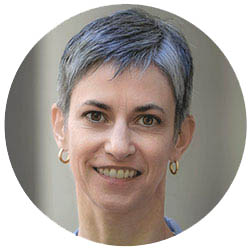
Experts: Medicaid Cuts Could Prove Fatal for Thousands
Historic Coverage Loss Could Cause Over 51,000 People to Lose Their Lives Each Year, New Analysis Finds
News | Video
The unwillingness of large numbers of nurses to work in facilities that maintain poor nurse working conditions is creating a critical labor shortage across the U.S. hospital and long-term care industry. As she opened a December 1 Penn LDI virtual seminar on the topic, moderator and LDI Executive Director Rachel M. Werner, MD, PhD, asked the four panelists: “How did the labor market become so broken for nurses, and how do we come back from that?”

The panelists were: David Benton, PhD, RN, an Adjunct Lecturer in the Harvard Global Nursing Leadership Program and former Chief Executive Officer of the National Council of State Boards of Nursing; Bianca Frogner, PhD, Professor at the University of Washington’s Center for Health Workforce Studies; Gopi Shah Goda, PhD, Senior Fellow at the Stanford University Institute for Economic Policy Research and former Senior Economist at the White House Council of Economic Advisers; and Karen Lasater, PhD, RN, LDI Senior Fellow and Term Chair of Nursing and Health Policy at the University of Pennsylvania School of Nursing.
“This is not a case of the work being difficult,” said Lasater, “rather it’s about the organizational failures that are hindering nurses from doing their work effectively that drive nurses to feel burnt out. In a recent study, we asked nurses ‘What would be the most important intervention that your hospital could do to prevent your burnout or reduce your burnout?’ The vast majority of respondents said improving nurse staffing levels was the most important intervention that hospital administrators could take. So, there is a real mismatch between what hospitals think they should do and what nurses want them to do. Nurses say appointing clinician wellness champions is not effective. Providing resiliency training and throwing pizza parties is not effective. What nurses want and need are manageable, safe workloads.”
Like many other nurse scientists who have been researching the issue for years, Lasater is frustrated that the press and policymakers continue to cite a “nursing shortage” that causes the public to assume that in absolute numbers, there aren’t enough nurses across the country. Her and her team’s research at the University of Pennsylvania School of Nursing’s Center for Health Outcomes and Policy Research (CHOPR) have documented that this is not the case. In fact, the current U.S. population of 4.7 million licensed registered nurses is more than the country has ever had and more are coming out of school every year.

The problem, in this age of the industrialized and massively consolidated medicine enterprises, is that so many hospitals have created seriously understaffed, high-stress working environments that large numbers of nurses simply refuse to work in. And those who are working in them continue to experience the constant chaos and stress that has caused at least 100,000 of them to bail out of hospital nursing altogether in the past two years. Surveys have found that 600,000 more say they intend to leave the hospital employment by 2027.
“It is a vicious cycle,” Lasater said. “Nurses work in bad environments. They leave, they tell other nurses, ‘Don’t go work in that hospital.’ And that results in the nurses who stay there having even worse working conditions and even lower morale. If I were a hospital administrator, I would try to be proactive and address the reasons why nurses are leaving. This is a nurse retention issue. It’s not a nurse pipeline issue.”
Another frustration for nursing researchers is that the poor working conditions that are driving out nurses isn’t just a labor issue. Investigations have shown that the quality of patient care is significantly worse in the same poor nursing environments staffed by inadequate numbers of licensed nurses. But most policymaker comments and press reports fail to connect hospitals’ poor nursing working conditions with the direct harm done to patients who fail to receive adequate care.

Discussing the economics of significantly expanding a hospital’s nursing staff, Shah Goda asked, “Why are hospital administrators not investing more in this workforce? We need to understand what the barriers are to that. If it turns out that there are some market failures here that we need to correct with government policy, then we need to identify those.”
“This is a market heavily driven by reimbursement rates from Medicaid,” Shah Goda continued. “There’s some evidence in very high-quality research studies that suggest that increases in Medicaid reimbursement rates do seem to be causally related to an increase in the number of skilled nurses per patient. So that points to a policy lever that could be something to talk about in terms of what could actually impact what we think might be a labor supply shortage of nurses.”
Frogner agreed that hospitals are struggling financially as they come out of the pandemic but said “that burden should not be borne by the employees. The burden should go back to the federal or state governments that need to step in to help fill the gaps or figure out what are the best mechanisms to make the supporting of workers more sustainable.”

“There are also other things that have value for nurses, such as child care,” said Frogner. “Our health workforce is very female dominated and many of those women are also the primary caregivers in their homes. So, is there something that hospitals can do to support childcare, whether it be subsidizing it or providing childcare on site? Can they help to subsidize transportation costs? Can they make sure nurses are not paying for parking? These all seem like small things, but when you start adding up those costs, they have real wage consequences.”
“The question isn’t just ‘Why aren’t hospitals or skilled nursing facilities doing something,’ but rather, ‘Why aren’t policymakers doing more?'” Frogner continued. “In long term care, that’s been particularly surprising given just what a mess it has just been throughout the pandemic. I think part of it is this question of political will–where is the political will to make some of the changes happen?”
Frogner also noted how hospitals’ intense use of travel nurse agencies during the pandemic demonstrated how nurses eagerly flocked to positions offering more flexible hours and higher wages in temporary nurse service. She said that hospitals’ use of travel nurses continues to decline post-pandemic, but it’s been difficult to extract insights about the dynamics of that because of the lack of data. “We don’t have good national data on either nurse travel agencies or detailed hospital data on workforce to help us understand what has been happening. I know the Centers for Medicare and Medicaid Services (CMS) is making a real effort to try to collect data and put it out there on a more real time basis, and we could probably benefit from that across more health care settings.”
Benton focused on the overarching efforts of the National Council of State Boards of Nursing (NCSBN) to establish more standardized rules for licensure policies enabling nurses to easily practice or move across state lines or collaborate in high-tech, networked delivery systems.

“We need to start to be much more creative in our workforce models that don’t just focus on a name like a ‘nurse’ or ‘physician,’ but actually think about the competencies,” Benton said. “So, having a resource that actually interfaces with multiple intensive care units, not just across a state, but potentially across several states, how do we actually plan workforce practices for some of that as well?”
“The variation between scopes of practice in different states is becoming less and less of an issue as the NCSBN introduced things like the Nurse Licensure Compact and the Model Act & Rules that are now being based on evidence rather than opinion,” Benton said. “We’re starting to see states migrating toward a more standardized approach. And we’re looking at how the pandemic drove a massive increase in the provision of services through telehealth technologies. So, the way that we start to plan a workforce for the future is not simply about the local labor market, but it’s about how that labor market will be deployed potentially more widely through, for example, the internet of things.”
As the session ended, Werner asked each panelist to recommend a state or federal policy change that might meaningfully address the nursing workforce issue:


Historic Coverage Loss Could Cause Over 51,000 People to Lose Their Lives Each Year, New Analysis Finds

Cited for “Breaking New Ground” in the Field of Hospital Operations

Men are Stepping Up at Home, but Caregiving Still Falls On Women and People of Color LDI Fellow Says

More Flexible Methadone Take-Home Policy Improved Patient Autonomy

Penn LDI Seminar Details How Administrative Barriers, Subsidy Rollbacks, and Work Requirements Will Block Life-Saving Care

His data-driven initiatives risk violating consent, spreading stigma, and reviving vaccine misinformation, LDI Fellow writes.